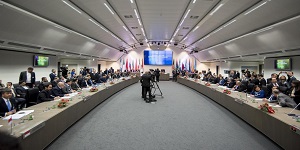
OPEC non-OPEC Meeting in Vienna
OPEC and its other non-members have agreed to extend cuts in oil output by nine months in an effort to bolster prices on world markets. The decision, made on May 25 at a meeting in Vienna, will mean that the cuts will remain in place through March 2018. A previous deal was due to expire on June 30 2017.
The Organization of Petroleum Exporting Countries and 11 non-members agreed last year to cut output by as much as 1.8 million barrels a day.
Five months into the original deal, brokered by OPEC's dominant player Saudi Arabia with support of the non-OPEC giant Russia, supplies have not been curtailed that much and prices have fallen around 5 per cent. The supply reductions were initially intended to last six months from January, but the slower-than-expected decline in surplus fuel inventories prompted the group to consider an extension. U.S. crude futures have rebounded by about 13 percent from a five-month low since Saudi Arabia first proposed maintaining the curbs into 2018.
The deal has only held, at around 97 per cent compliance of the 1.8 million barrel a day (mb/d) cut originally planned, due the Saudis going well beyond the call of duty.
The non-OPEC nations, marshalled by Russia - which produces even more oil than the Saudis - were supposed to deliver cuts of around 400,000 b/d.
“Kazakhstan welcomes and backs OPEC and non-OPEC members in their decision to extend oil output cuts agreement to keep suitable market prices”, stated the Kazakh Ministry of Energy.
“Kazakhstan intends to continue performing its obligations as per the existing quota of 20,000 barrels per day. In November 2017, the terms of the agreement may be revised with the consideration of the global oil market conjuncture” the statement reads. The statement added that Astana would meet its obligations and would reduce its output in May and in June.
The third-largest non-OPEC participant in the agreement pumped 1.76 million barrels a day in April, overshooting its target of 1.68 million, OPEC estimates show.
In the meanwhile, The North Caspian Operating Corporation, which develops Kashagan oil deposit, plans to increase oil output by 80,000 barrels per day. “Kashagan offshore field continues oil production as planned since it was resumed. It has just now reached 3 million tons. It is expected that the field will have produced 8m tons by year end”, President of the Kazakhstan Association of Petroleum Geologists Baltabek Kuandykov advised.
“The crude market is now starting to rebalance in earnest, but it will take time and the bulk of stockpile draws will come between June and September; OPEC and its allies will probably agree to prolong their agreement until the end of the first quarter of 2018” global head of oil at PIRA Energy Group Gary Ross said in an interview. “OPEC will achieve its stated aim of bringing fuel inventories back in line with the five-year average by the end of this year”, said Venezuelan Oil Minister Nelson Martinez.